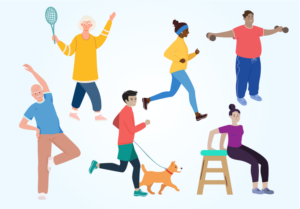The Benefits of Exercise

A lack of movement and exercise can be classed as a deficiency and it is estimated that people lose 30% of their muscle power between 50-70 years of age.
The body is designed to move and we are blessed with the biomechanics to achieve this whether it be crawling, walking, running, climbing, cycling or swimming. Remember that human beings have been Hunter/Gatherers for 90% of our existence and only 10% as agriculturists; the latter starting the rise of a much more sedentary lifestyle. Physiologically, food is now comparatively easy to obtain compared to our ancestors as a quick drive to a supermarket or fast-food restaurant delivery can typically be achieved within minutes and with very little energy expenditure.
Global research has shown that more than a third of people do not attain the standard recommendation of 150 minutes per week of moderate exercise. More worryingly only 5% of people perform 30 minutes of physical activity each day and the concerning thing here is that these thresholds for exercise are not particularly challenging. Moderate exercise includes walking fast, water aerobics, riding a bike on level ground or with few hills, doubles tennis, pushing a lawn mower, hiking, skateboarding, rollerblading, volleyball and basketball. Only one in three children are physically active every day and only 28-34% of adults aged between 65-74 are physically active. A must self-acknowledgement is reasoning that being busy does not mean being active!
The body and exercise have an almost symbiotic relationship because many of our internal organs and bodily systems are dependent on our movement to improve their function of keeping our body in good shape and likewise exercise cannot take place without the body’s homeostatic capabilities.
This is an overview of what happens to our bodies when we exercise. The lungs require nearly fifteen times more oxygen during physical activity so we start to breathe deeper and faster as more oxygen is inspirated and more carbon dioxide is expirated. The body’s watchdog, the Hypothalamus, orchestrates the HPA (Hypothalamic-Pituitary-Adrenal Axis) which stimulates the release of stress hormones Cortisol and Adrenaline which enable the body to react to the physical activity in the form of sending more blood to the heart and muscles. Cortisol aids in the breakdown of glycogen stores in the Liver which is converted to glucose and is used as fuel by the perpetually contracting muscles. Fuel is carried in the body by Adenosine Triphosphate (ATP) which quickly depletes because of the low stores of it in the body. More oxygen is required to synthesise more ATP so that more oxygen can be shunted to the hard-working muscles. Adrenaline increases the heart rate which increases oxygen circulation to the body so the former processes can be powered. The repetition of exercise improves the efficiency of the heart in being able to achieve this function. Activation of the HPA also stimulates the pituitary gland to release Growth Hormone which directs the body to break up fat stores instead of muscle breakdown. The Hypothalamus also responds to the increased body temperature, caused by exercise, by dilating the surface blood vessels of the body thus increasing blood flow to the skin which starts sweating to release the increased heat and thus maintain a stable core body temperature. This is an important function obviously but the skin (the largest organ in the body) also is responsible for eliminating 1/3rd of the body’s waste and toxins so exercise stimulates this process as well.
The brain immediately benefits from increased blood flow during and after exercise which results in better attention and greater alertness. Endorphins (opioid brain chemicals) are released which make you feel positive and relieve stress and pain whilst Dopamine and Serotonin (neurotransmitters) output by the brain and stomach respectively increases which aid a positive mood which puts the “pep in your step”. Studies have been shown that exercise can reduce depression by at least 20%.
The digestive tract effectively is down regulated as blood is directed to the muscles which is why it is generally suggested that no food should be eaten immediately prior to exercising. The kidneys initiate greater water reabsorption and reduce urination in order to keep the body as hydrated as possible.
“Exercise is the key not only to physical health but to peace of mind.”
Nelson Mandela
What are the beneficial aspects on the body by doing regular exercise?
- Modern day life serves up fight/flight hormones every day for most humans and without exercise these hormones linger in the body. Exercise uses up the released fight/flight chemicals (cortisol and adrenaline).
- Bone strength increases due to muscle contractions during exercise and the bones absorb greater amounts of Calcium. Weight lifting and resistance exercises are particularly good for improving bone quality.
- Use it or lose it. Regular exercise will increase strength, flexibility, endurance and balance.
- Slows down the aging process. Researchers have shown that exercise keeps our DNA healthier by making our Telomeres longer and turning off the aging process within our Chromosomes (a DNA molecule in most nuclei of each of our cells). Telomeres are caps on the end of a chromosome and generally shorten as we age.
- Enhance mood, reduce degeneration of the nervous system, increase self-esteem and decrease guilt if we overindulge in the naughty things like sweets and chocolate. Exercise also gives a sense of daily achievement.
- Exercise can decrease weight, burn fat, increase muscle mass, decrease the risks of obesity and diabetes. This is basically due to an increase in the body’s metabolic rate.
- Exercise has a great effect on the cardiovascular system and can reduce blood pressure and cholesterol. The efficiency of the heart and blood vessels are improved.
- Exercise stimulates the lymphatic system and improves immune system function. The body relies on the lymphatic system to remove waste such as bacteria, viruses, toxins and abnormal cells; the latter can build up and progress to cancerous cells. Lymph fluid relies on movement and the contraction of muscles to make it flow because the lymphatic system does not have an organ like the heart to pump fluid around your body.
- Exercise aids detoxification by stimulating the skin to sweat and excrete toxins and waste. Skin tone improves and looks younger as more blood and oxygen are pumped to the skin cells.
- Exercise improves blood flow to all parts of the body and the fitter the body becomes then the less amount of blood is required to be diverted from the digestive system because the muscles and lungs need less blood. The digestive tract becomes more efficient as metabolism improves with regular exercise. This is especially important because as we age our metabolism slows down and the weight can creep up insidiously.


